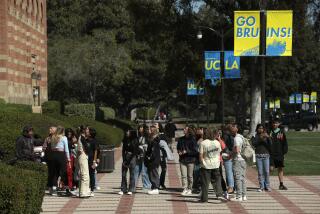UCSD Medical Center Stops Liver Transplants
- Share via
Stinging from a string of failures, UC San Diego Medical Center has put its liver transplant program on hold indefinitely while it calls in outside experts to figure out why all four liver recipients there died.
The action marks a second major setback for liver transplantation in San Diego. Sharp and Children’s hospitals discontinued their joint program in 1984 after five out of six patients died.
The head of liver transplantation for UCLA Medical Center, Dr. Ronald W. Busuttil, and another international expert will visit UCSD Medical Center next month to review the year-old program.
Busuttil said he hasn’t yet been given details about what his review will entail. However, he expects “to make some suggestion of what things need to be changed, if any. I presume they’re going to ask me to review those four cases.”
Began in March, 1987
After two years of planning, UCSD began its liver program March 9, 1987, with a transplant on a middle-aged Linda Vista woman. Her bile ducts--essential to secreting bile for digesting fat--had been destroyed by a disease called primary biliary cirrhosis. But her body rejected both that liver and a second one, and she died.
The second patient’s new liver failed eight weeks after his April 1, 1987, transplant. Then, when the next two transplants were done Jan. 3 and Feb. 10 this year, the situation worsened. Both patients died on the operating table, one from complications of her liver disease and the other from massive bleeding.
Six days after the last death, the head of the liver transplant program, Dr. Oscar L. Bronsther, quit his post and the program was put on hold. Bronsther remains a member of the hospital’s kidney transplant team, however, said Pat JaCoby, spokeswoman for the hospital.
Busuttil declined to comment on the specifics of the UCSD transplant cases until he can study them, but he added, “Obviously, a zero percent survival rate is not good.”
Survival Up to 90%
UCLA’s program, after initial problems when it began in 1984, had a 70% survival rate in its first year, he said. That is up to 90% so far for the 40 transplants performed this year. The hospital has done 250 during four years, he said.
The UCSD deaths not only represent an embarrassment for the hospital but also raise the possibility that, if the liver transplant program resumes, it could be a major drain on the hospital’s annual budget for an extended period.
“If you look at third-party carriers and Medi-Cal, and you look at what they require to approve a program for liver transplant status, they are all requiring at least 65% survival for the first year,” Busuttil said.
Few patients can afford the cost of the operation, and liver transplants are not covered by Medi-Cal or the military insurance program called CHAMPUS until the program has a high success rate, JaCoby said. Blue Cross of California is in the process of developing similar guidelines, said Jeannette Hartman, spokeswoman for the health insurer.
Hospital Paid Costs
The cost of two out of the four liver transplants at UCSD was borne by the hospital, at a cost of $75,000 each, JaCoby said.
If that proportion were to hold up in a revived transplant program, the hospital would face at least $375,000 in costs for liver transplants if the hospital performed just 10 per year.
However, the true cost could be higher. At UCLA, a liver transplant costs $150,000, double the figure quoted by UCSD officials.






